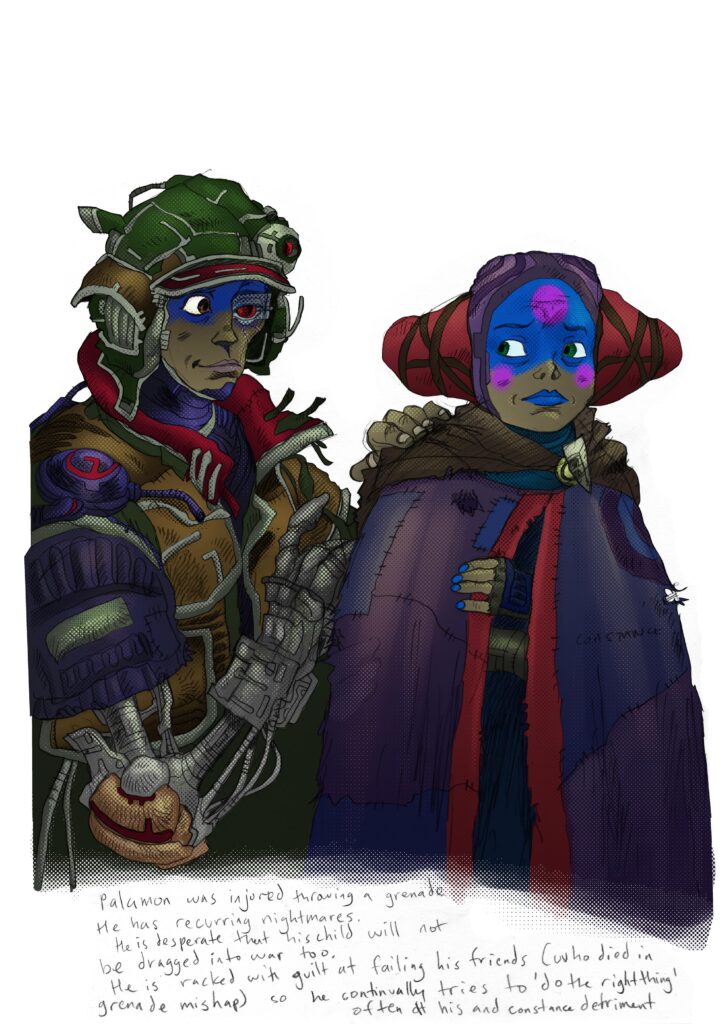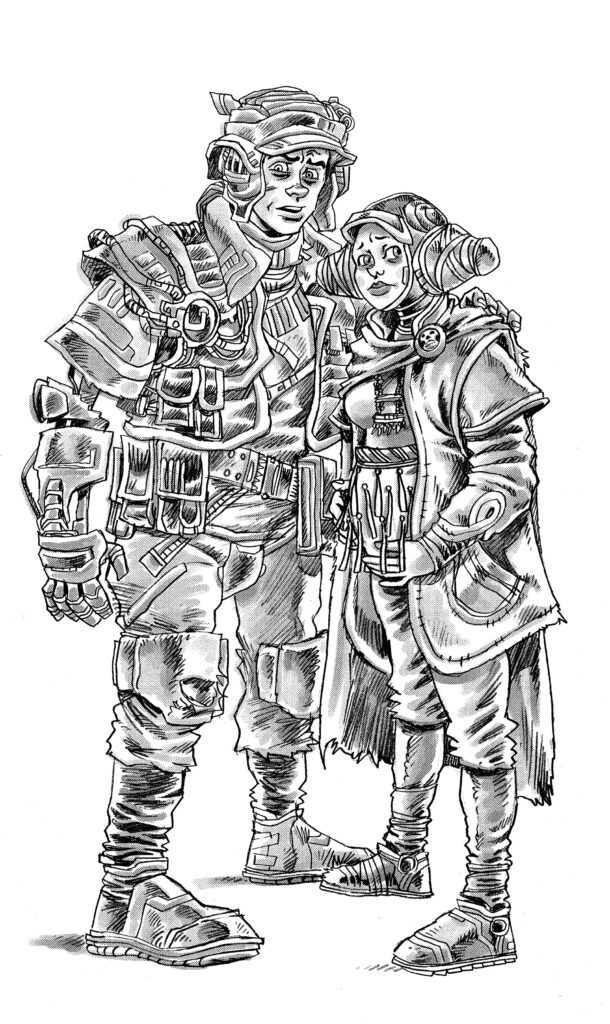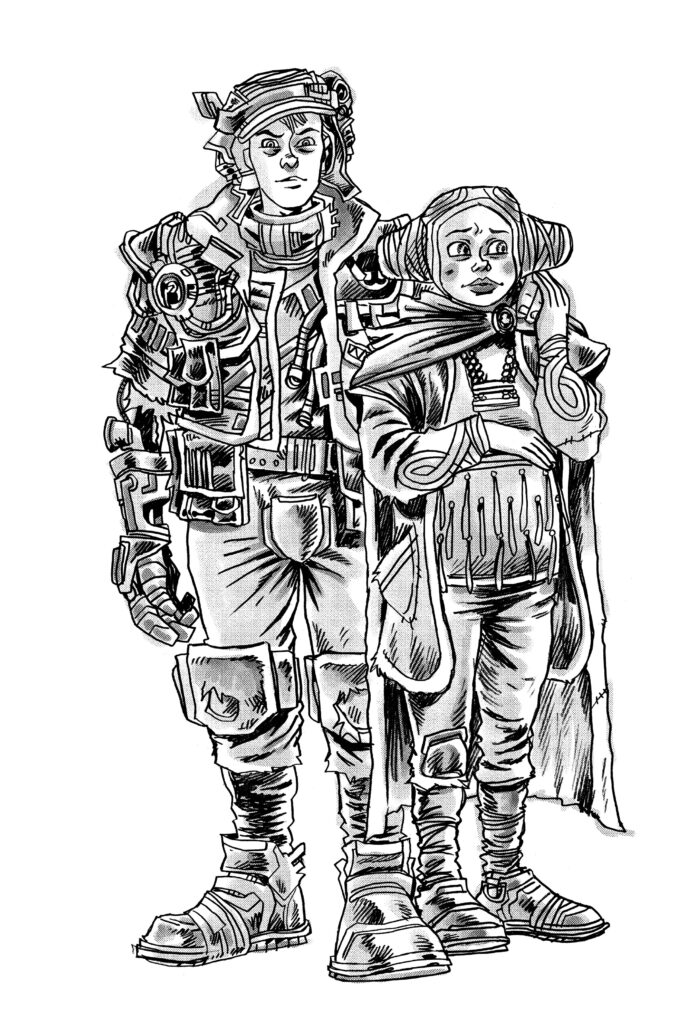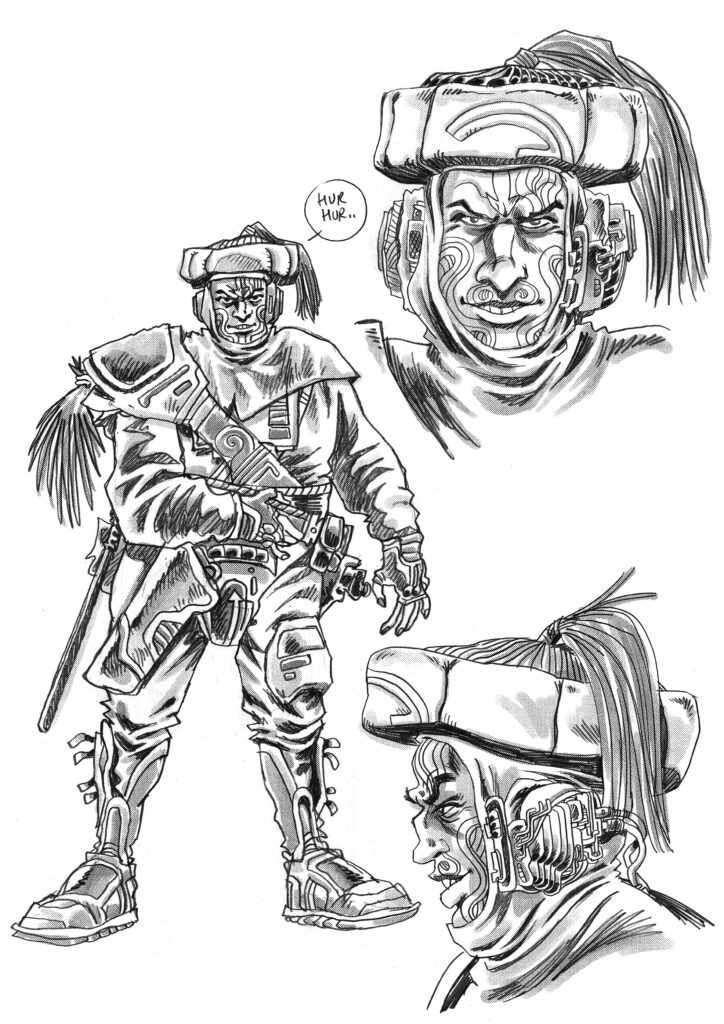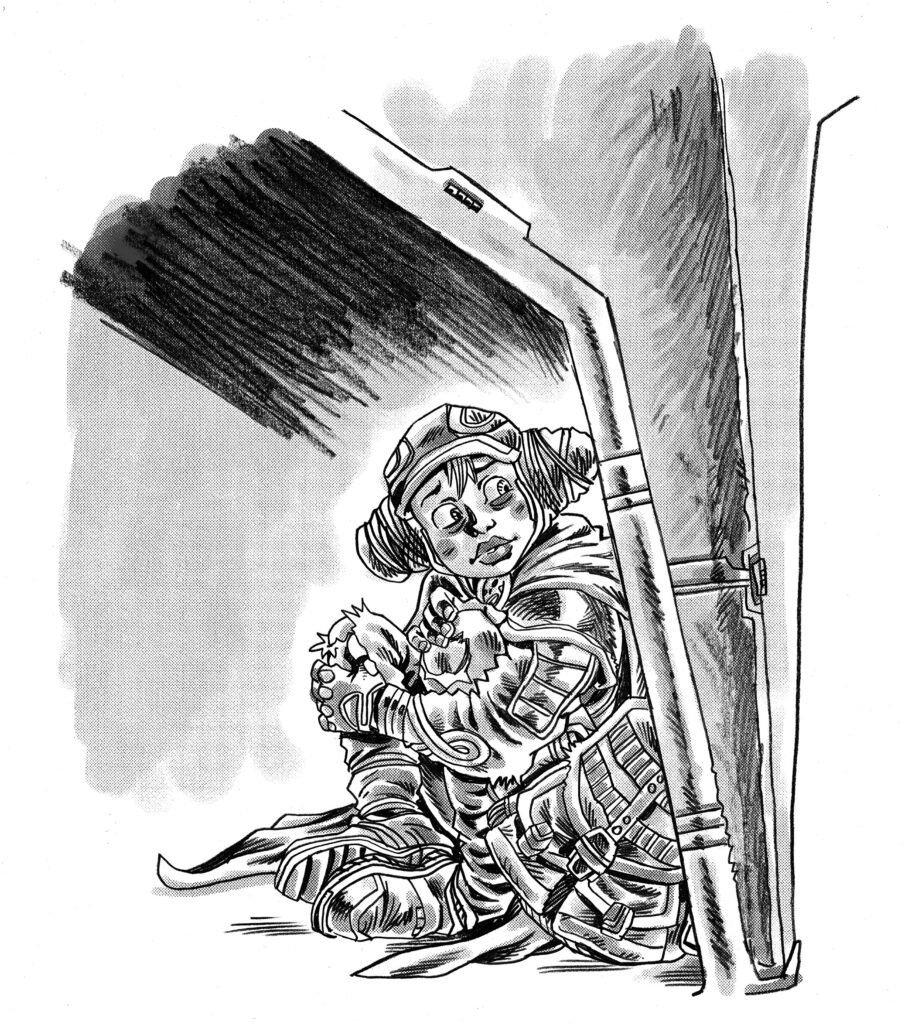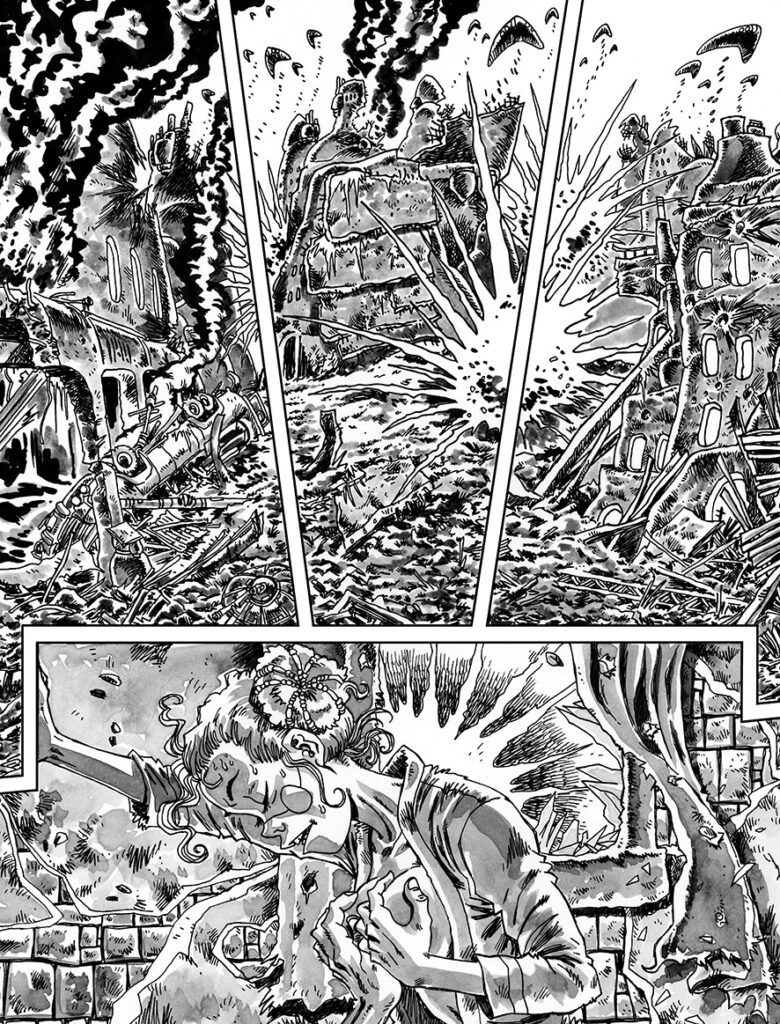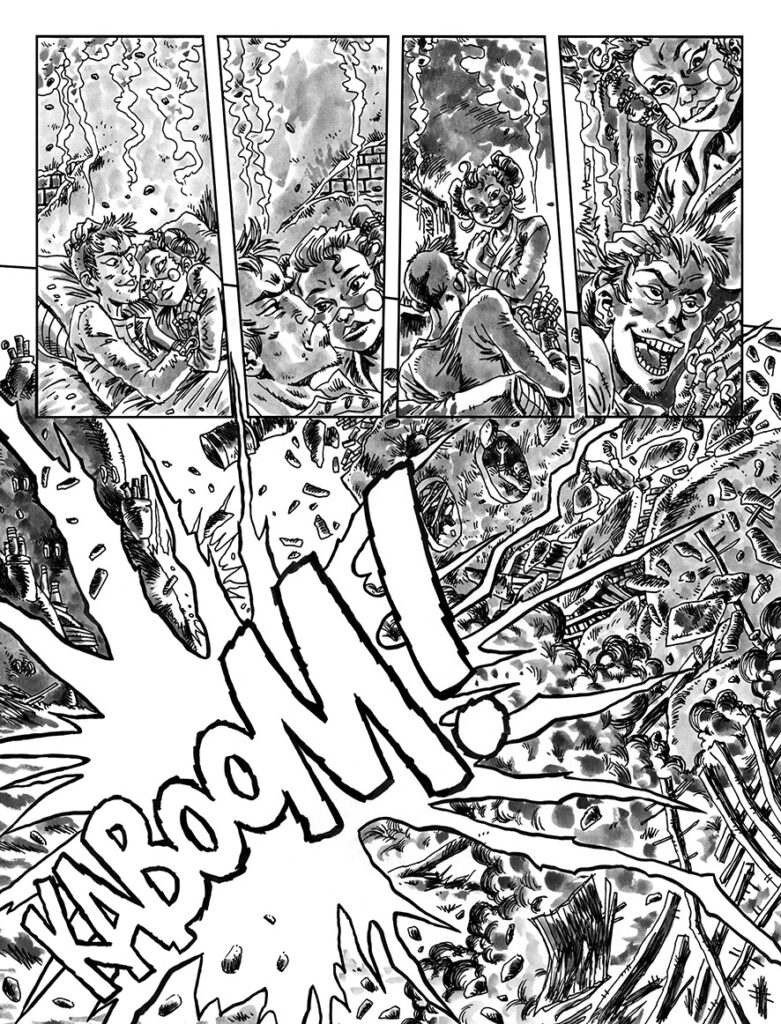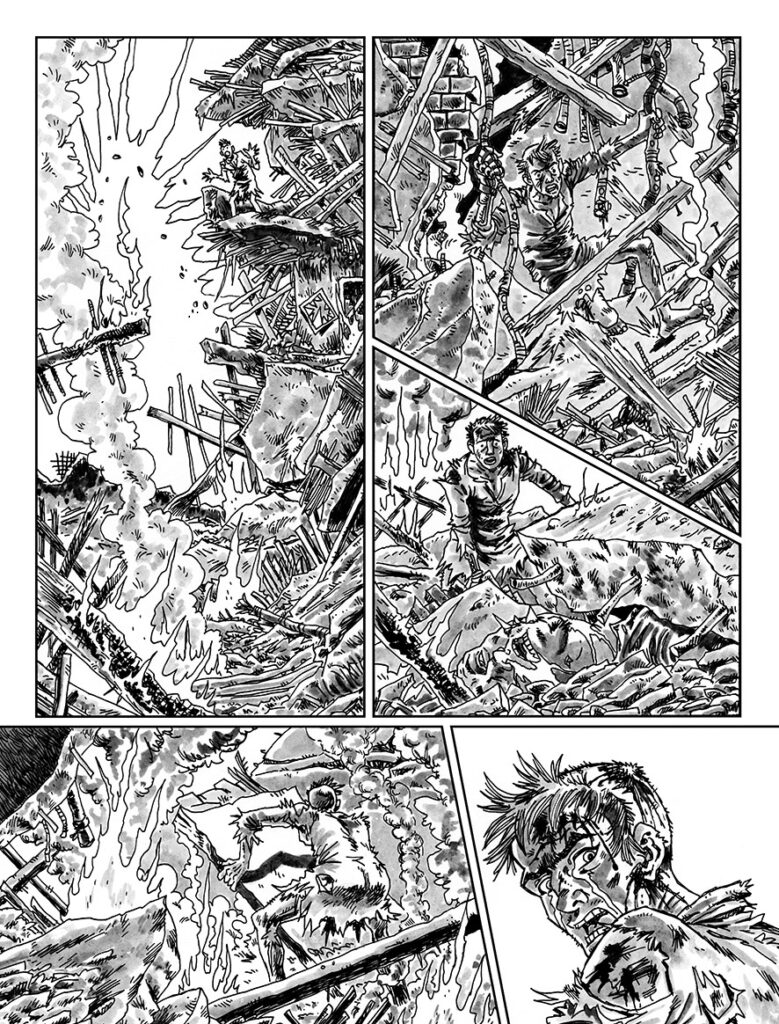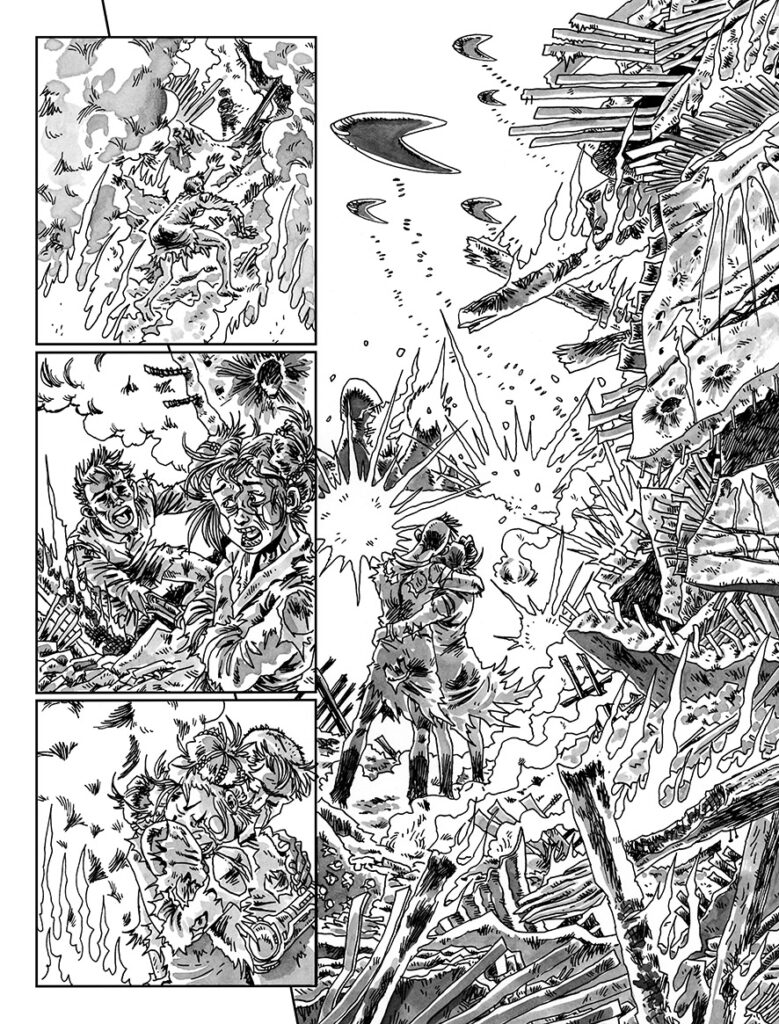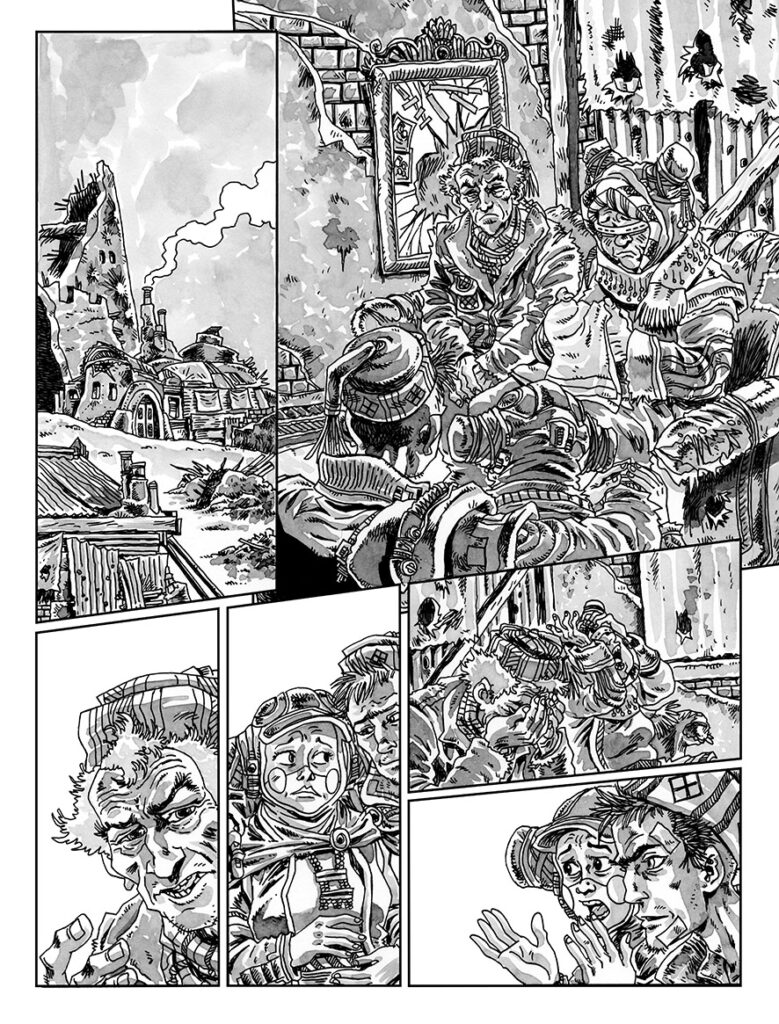Interview: All Aboard The Devil’s Railroad with Peter Milligan and Rufus Dayglo
23rd October 2023
Beginning in Prog 2352, The Devil’s Railroad by Peter Milligan and Rufus Dayglo is classic 2000 AD sci-fi, bringing you a politically charged sci-fi love story with a powerful take on the refugee crisis.
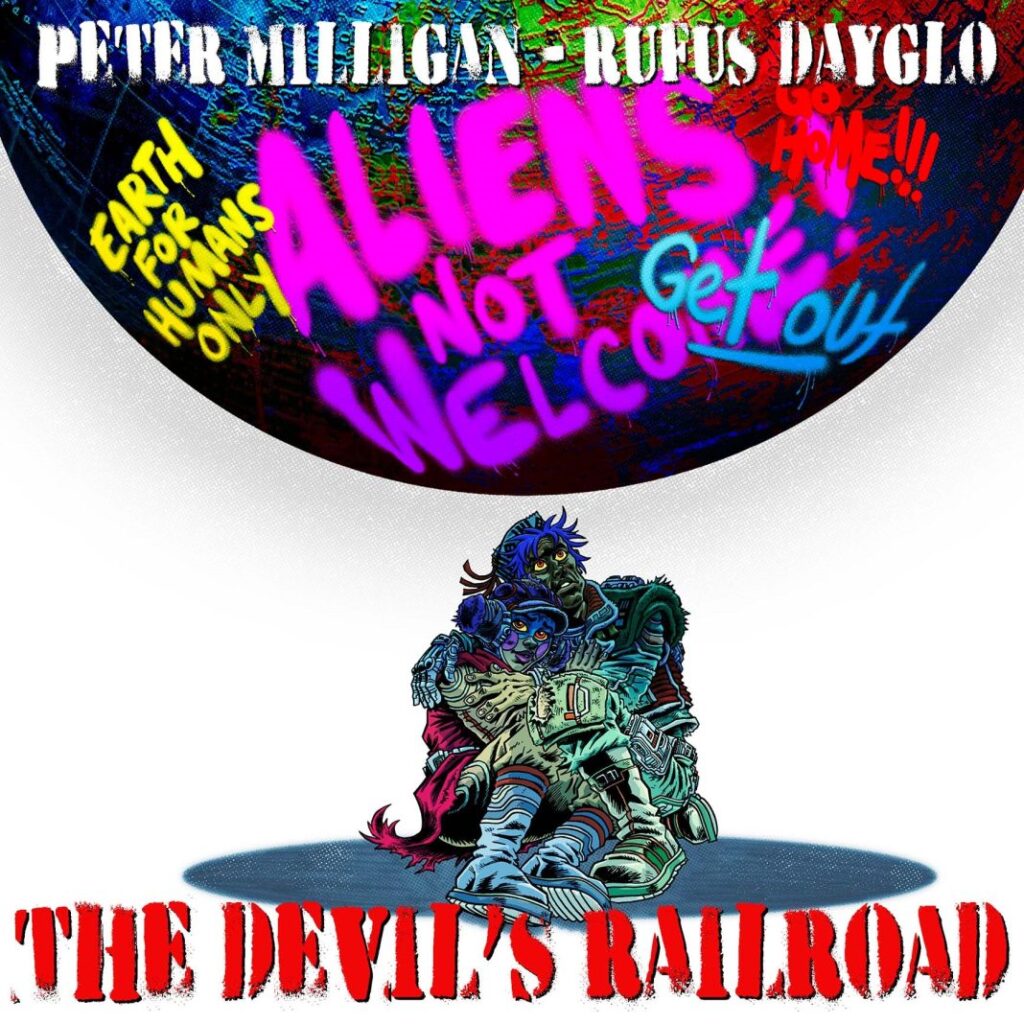
Set in the Year 3038, the series follows young couple Constance and Palamon, who’re living on Diaspora X-167, a planet right in the middle of a warzone. It’s no place to be young and in love. And it’s definitely no place to raise a family – because they’ve just found out Constance is pregnant.
Like so many faced with similar life-threatening situations, they choose to run, to evacuate, to seek sanctuary to protect the new life they’ve made. So they begin the dangerous journey from their home planet to get to Earth, where all Earth-born humanoid babies are granted citizenship with full Earth rights, giving their child a chance of a future.
But the only way they can get there is along the smuggling route known as The Devil’s Railroad…
It’s hard-hitting contemporary science-fiction that does what all great sci-fi does, shines a light on the social and political troubles we face right here and right now.
The Devil’s Railroad began on 4 October in 2000 AD Prog 2352 and episode 3 is in Prog 2354 – out right now!
Now, how about we have a chat to series creators, Peter Milligan and Rufus Dayglo?
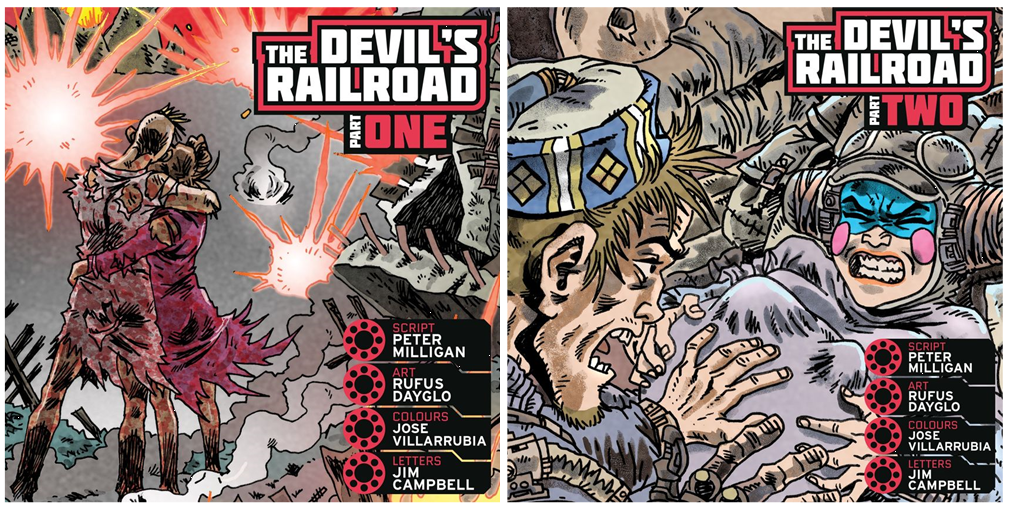
Peter, Rufus, nice to be talking to you again and just as nice to see you in the pages of 2000 AD once more. Is it good to be back?
PETER MILLIGAN: This remains to be seen! But seriously, I’ve really enjoyed the work Rufus and I have done together for 2000 AD – Counterfeit Girl is a real favourite of mine – and it’s great to see the next stage of our partnership.
RUFUS DAYGLO: Personally, I am really excited as this series is very close to my heart. It’s a real honour creating something new with Peter.
Let’s begin with the obvious, The Devil’s Railroad began in 2000 AD 2352. Can you both give us the lowdown on what to expect from the series?
PM: In short, it’s about refugees. It’s an often dark but always human story about that most basic and perhaps ancient of human impulses: the impulse to flee danger and seek out a better life for you and your family. Our heroes take the so-called Devil’s Railroad that they hope will take them to Earth, and a better life. It’s a harrowing journey through an unfriendly and sometimes bizarre universe.
As I write this, Suella Braverman has just made her ‘hurricane of mass migration” speech, so this story is obviously just as topical as when we created it.
RD: This is an all new story/series about a young couple escaping war on their planet… it’s a look at the dangers, difficulties, barriers and gangsters they have to face, and hopefully overcome. Peter has perfectly managed to balance the black humour and absurdities that people face to find safety and sanctuary.
How many episodes have we got to look forward to here?
PM: Oh, a lot. An awful lot.
RD: There are 14 episodes, and I’ve drawn 3 covers for the Prog as well… so am excited to see these in print!
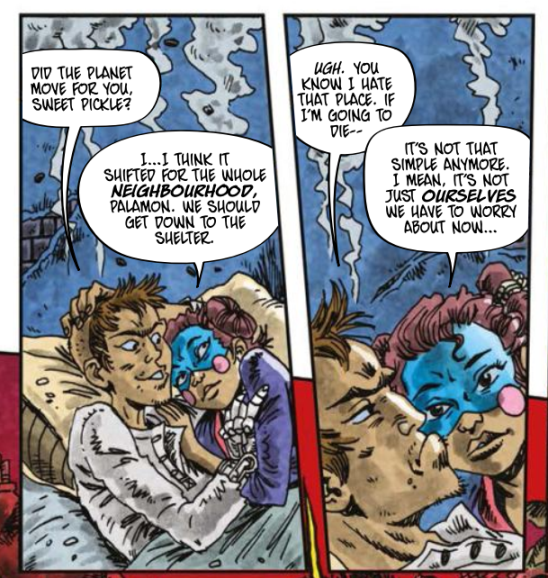
In the first episode, we’re quickly introduced to Constance and Palamon and the situation they find themselves in – a war-torn planet, two young people in love, an unexpected pregnancy, a baby that they both know can’t be born into war, and a decision made to throw all their lives into danger by heading out onto the illegal people smuggling route of the Devil’s Railroad.
PM: Well, you’ve just pretty much given away what happens in the first issue. Thanks a bunch, Richard!
Hey, that first episode was out a couple of weeks back! Constance and Palamon have already moved on from there in episodes 2 & 3 so we’re okay to mention those plot points – anything else and it’s the wrath of Tharg for me (again!)
How did the story come about? Were you planning on working together again and this just popped into your collective heads? Was it Peter’s idea that seemed perfect for Rufus’ art?
PM: Often, I create and write the story and then we find an artist, but it was a bit different with Devil’s Railroad.
We both wanted to work on something again and the theme of refugees seemed right. Rufus was living in Berlin at the time and witnessed some of the struggles of refugees there. I was seeing news items about refugees every day, as well as seeing the destruction of cities like Aleppo.
RD: The story actually started after I had finished up Counterfeit Girl with Peter. I was living in Berlin at the time, and a lot of Syrian refugees were arriving. They were forced to live in hostels which they were kicked out of during the day, so I made some acquaintances with some amazing Syrian people all desperately wanting to work and be a part of this new society. They faced so much bigotry and it really affected me. I wanted to make something addressing why people leave their beloved homes to try and start again.
Talking to Peter, we both decided we’d like to work on a sci-fi series about refugees and so we then pitched it to Tharg Almighty at 2000 AD, who granted us a ration of stryofoam cups and pencils.
Since we started the project, the subject matter has become even more important, especially in the UK and Europe.
PM: I think that 2000 AD has always been a place where stories that are satirical, political, or simply about the human condition can find a home, and I see The Devil’s Railroad as part of that fine tradition. I don’t want to give the impression this is all doom and gloom. There’s humour and weirdness in here too, as you’d expect from me and Rufus.
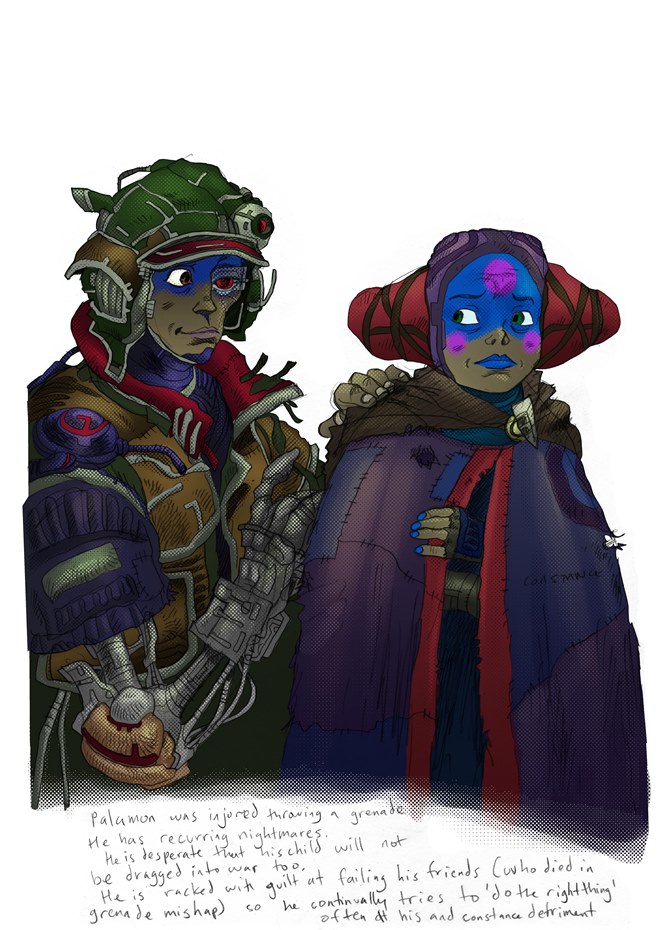
‘I only did a few character sketches before starting the series, and I wanted Palomon to have a prosthetic arm, and I built him a little unused back story. It helped me, as it made his cocky headstrongness make sense.’
>
After that first episode, where will you be taking us? – I doubt it’s going to be plain sailing for the lovers, that would be far too simple!
PM: To say that The Devil’s Railroad is a circuitous journey would be an understatement. Palamon and Constance have to travel half-way across space…and there are some very strange people and things out there.
RD: Our young love birds are in for incredible strange times, and a very rough ride ahead. They will have to make friends and allies, and will face some very determined attention from people smugglers, animosity from other refugees, betrayal, hungry space worms, traverse perilous burning walkways and may have to literally sell their souls!
They are willing to risk absolutely everything for their unborn child to have a fresh start on Earth. They are under the misguided idea that they will be welcomed on Earth just as equals, as so many desperate refugees are discovering in real life from our abhorrent ‘Government’.
What’s the core idea in The Devil’s Railroad? The elevator pitch if you will?
PM: Elevator pitch? A better life might await two young lovers on Earth. But they have to go through hell to get there.
RD: For me, This is a story about young love, and the head strong misguided attempts to protect each other at all costs from a hostile and extremely uncaring environment… in a desperate attempt to build a viable future for themselves.
Oh yes, the political aspect of it is just one part – the other thing we have in The Devil’s Railroad is a classic love story – alien boy and alien girl in love, having their baby in the worst of circumstances, desperately trying to find sanctuary, to find a new home.
PM: Absolutely. It’s a love story. Romeo and Juliet, where Juliet’s pregnant, they’re both aliens — and the whole universe seems to be against them.
But the universal love story here both highlights the desperate situation that the lovers find themselves and also gives it another aspect. It really gives it that, for want of another word, ‘human’ touch.
PM: Couldn’t agree more.
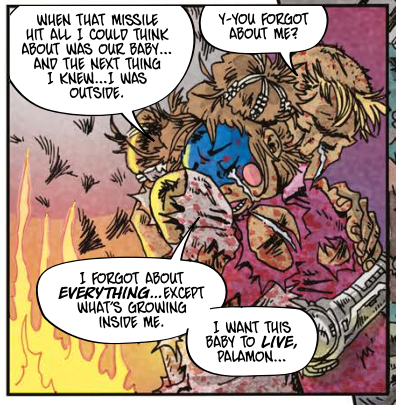
There’s a beautiful moment in the first episode here, as the two are reunited in the rubble after a near-miss on the latest bombing raid to hit Diaspora X-167… the line ‘I want this baby to live, Palamon… and I want it to have a better life than this.’
In that one line, you get to the heart of everything that drives both the Devil’s Railroad and the reason for migrants/refugees to take such terrible risks to get to someplace that they think will be better.
PM: It’s a heart-wrenching, universal, timeless story, what can I say?
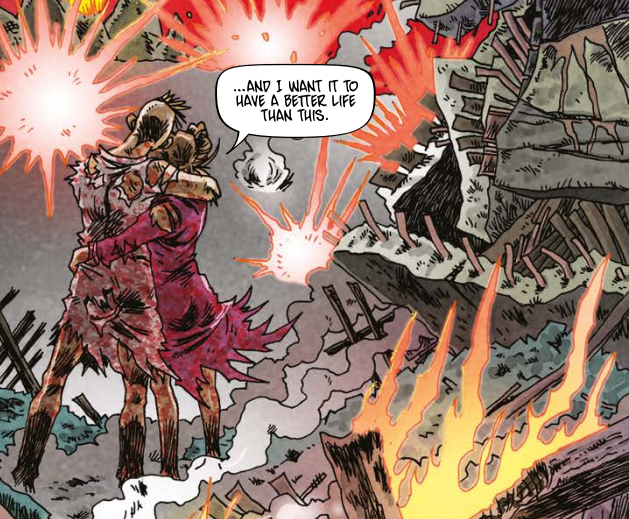
As with any completely new series, there must have been an awful lot of preliminary work and world-building with Devil’s Railroad?
When you’re getting together on a strip, how does it come together and then how does the collaboration proceed?
PM: After we’d decided on the kind of story we wanted to explore, it’s usually down to me to do the heavy lifting for a bit, working out the story, the world, the characters. But very soon, Rufus works on character designs and we discuss those, and the whole look of the ‘world’ of the story is developed. Because Rufus and I are friends it much easier to throw ideas and comments back and forth.
RD: On Counterfeit Girl, Peter had written the series already, and I was offered the opportunity to illustrate it and I did my best to make it my own take on his scripts, to create a world. I designed the colours as well, as I wanted it to look nightmarish and garish, as all the other sci-fi strips at the time were coloured like Ridley Scott’s Blade Runner still.
With Devil’s Railroad, when Tharg gave us the green light, Peter wrote the scripts, and I would then design and draw the world(s), episode by episode. I was getting them script by script, so I just had to create stuff as I went along, freestyling it and panicking!
It was an emotional rollercoaster for my tiny brain. Peter always throws in crazy enormous ideas, and it is always an awesome and slightly terrifying challenge working out how to visualise things! Haha! What I love about Peter’s scripts is they will throw you from high drama to absurdity in a moment. The Hemingway of Comics!
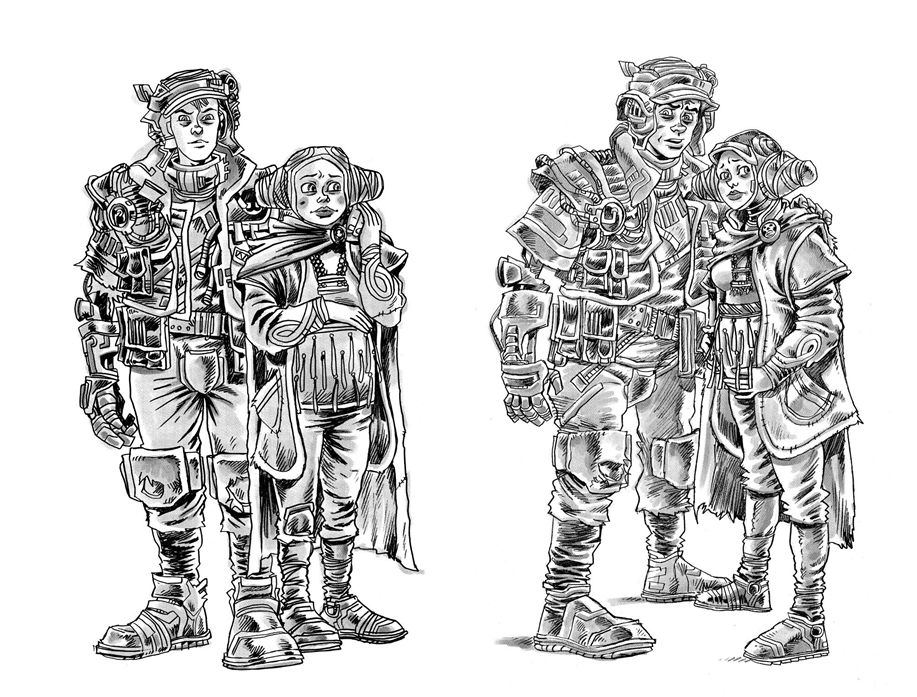
‘One mistake I ALWAYS make, is making my characterdesigns waaaaay too complicated. Why do I do this to myself?! It becomes very hard keeping track of all the gadgets and decorations, but I do my best.’
>
Over the past few years and past few stories in 2000 AD – Bad Company, Counterfeit Girl, and now The Devil’s Railroad, you’ve really reflected the worst of society today in your comics.
PM: As I said, I always see 2000 AD as an arena where these kind of subjects can be explored, in a more or less serious or satirical way. I like to think the stories you mention do a lot more than just show the worst of society, though. I think in all of them, even, just about, Bad Company, there’s a feeling of hope or some kind of redemption.
Counterfeit Girl was all about identity and identity theft, whilst your Bad Company tales were a hard look at modern warfare & proxy warfare, politics, and the complex issue of freedom versus security.
And with The Devil’s Railroad, you’re obviously addressing the issues of the refugee crisis, immigration, belonging, and identity.
Is it just that you’re so energised by what you see in the news and all around you that it filters into your thinking for new work or is it a conscious mining of the now?
PM: You write about what affects you. Sometimes that can come from what you see or read about in the news, sometimes it’s a kind of story version of an ear-worm that won’t leave you alone. A feeling, a snatch of dialogue, an arena you want to explore.
RD: I think for both Peter and I it’s a combination of both. We both are very aware of politics and its importance in our lives. Peter always managed to inject both humour and political dialogue into so many strips (hence why I was a huge Bad Company fan when I was a young reader). Peter’s writing was always a huge inspiration to me, as he balances the serious with the absurd.
I have always been hugely aware of politics (my family was very political, trade unionists and socialists) and having travelled a lot, I have had the opportunity to meet a lot of people, and a huge amount of displaced people. They aren’t just numbers on the news. Each has a very unique story.
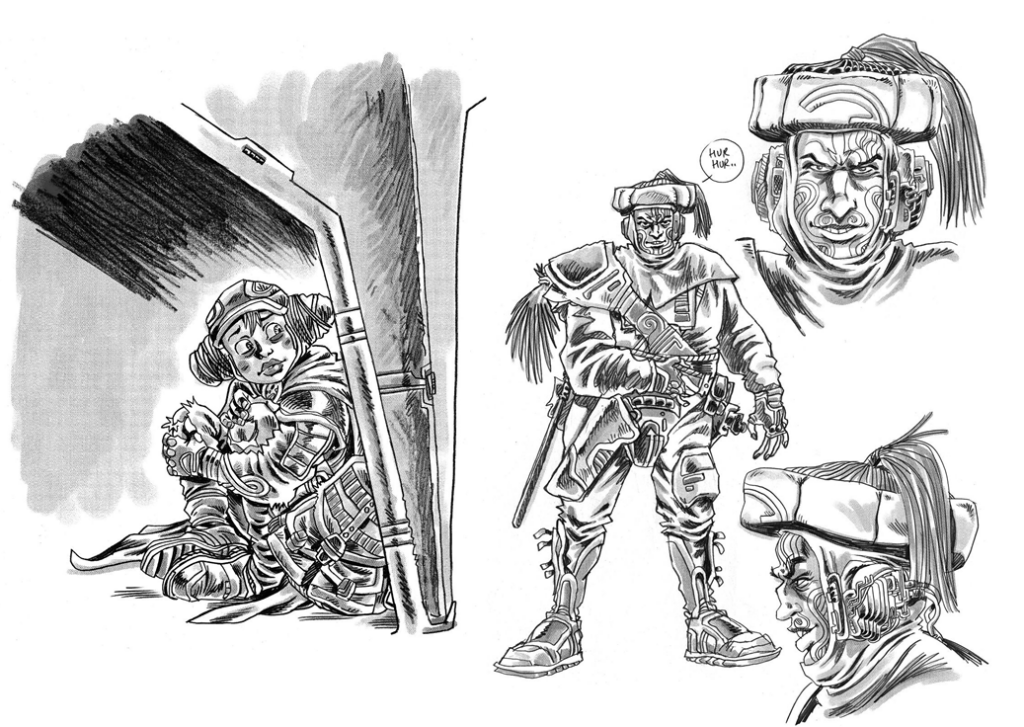
another study of Constance and one of (many bad guys from The Devil’s Railroad
>
Of course, this is what all good sci-fi does so well, digging into the modern-day issues, mixing politics, social issues, and satire and then dressing them in futuristic concepts.
Would you say that it’s something that’s far easier to sell at 2000 AD, who’ve been doing that mix of sci-fi, political and societal issues, and a healthy dose of satire thrown in since the very beginning?
PM: I don’t know about easier to sell. But it’s true that because of its fine history 2000 AD probably lends itself to certain kinds of story.
RD: Absolutely! 2000 AD has a long history of addressing Political issues and history, from Cold War politics, feminism, to more personal takes. It’s what comics do best. Comics’ history is a discourse about what is happening to US and our world.
2000 AD also offers a weekly format, so we can have short staccato episodes with cliff hangers…like old 1940s cinema adventures. It lends itself to these sorts of stories and adventures.
It’s important 2000 AD have new series too, as that was also one of its great strengths historically!
I wish there were more publishers open to doing politically orientated satire, but as most Comics companies are now owned by mega-corporations the last thing they want to do is challenge the status quo.
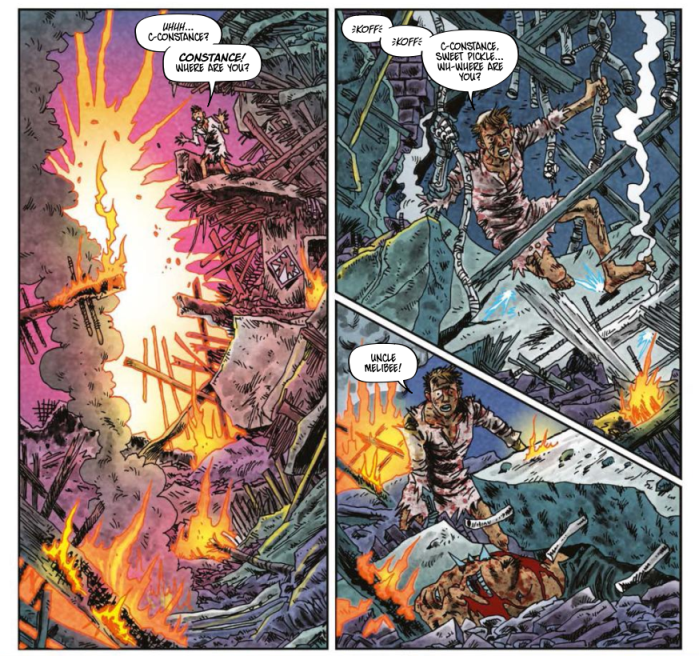
Now, the refugee focus that we see in The Devil’s Railroad here is particularly pertinent and polarising both worldwide and here in little UK, where each Home Secretary seems to seek to go further and further right-wing in their xenophobia and cruelty.
Was this something that you had specifically in mind as you were writing Devil’s Railroad or was it more that the global issue of refugees and asylum was fascinating?
PM: I’m not sure that the UK is in the only country that has a questionable – and getting more questionable by the day – attitude towards refugees. But to do a story particularly about UK Government policy – or, god forbid, the speeches of Suella Braverman – would be too narrow, too reductive. I’m more interested in getting into something a bit more universal.
RD: For me it was about addressing the humanity of all those that seek sanctuary.
We (the UK) failed terribly prior to the Second World War and in doing so condemned many European Jewish refugees to death. (There were huge diatribes in the British press about a plague of refugees and a huge amount of antisemitism, sound familiar??!)
Our present vile government is doing exactly the same thing and its actions are criminal and frankly, fascist. We need to have compassion, and also realise that through our country’s historical record we have helped create many of the dire situations now facing displaced peoples.
And what are your thoughts on the way things are going in the UK and the world as far as the refugee crisis?
RD: ‘The way the government treats refugees is very instructive because it shows you how they would treat the rest of us if they thought they could get away with it.’ As apparently Tony Benn once said.
We have a duty to care and help others. There are resources…but governments would rather divide us and convince us that someone fleeing war/starvation/natural disaster is our enemy. They are not.
PM: It’s a mess and it’s horrible, it’s also very complex. Though the situation might be ameliorated by international action I’m not sure it’ll ever be ‘solved’. Some people will always want to migrate to find a better life. Other people will try to exploit them. And other people will be worried that their already difficult lives will be made more difficult by refugees.
As Kurt Vonnegut would have said: So it goes.
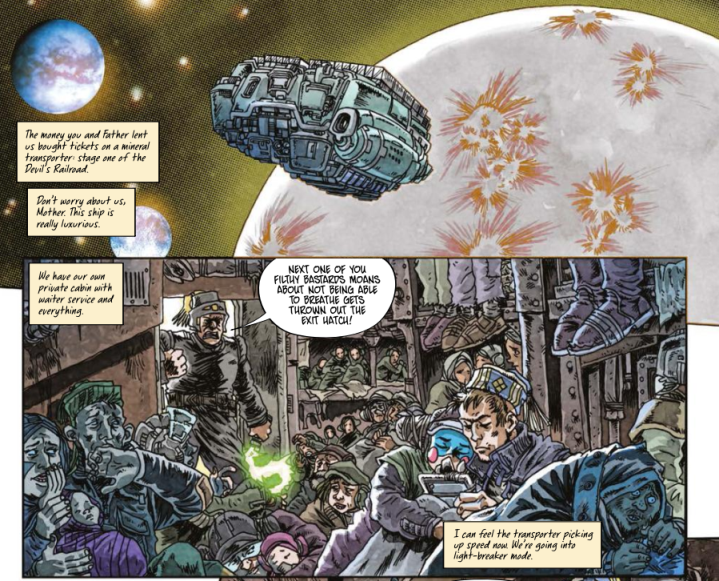
The 2000 AD PR for The Devil’s Railroad describes it as ‘a deeply resonant and powerful exploration at what drives people to leave their homes and seek a better life for themselves and their families, The Devil’s Railroad is a politically-charged series which deals with themes of home, identity, immigration and belonging.’
Seems that about covers it, wouldn’t you say? The seeking of a better life for themselves and their families? That’s the crux of it all.
PM: And thus will it ever be.
As with so many of the works you’ve done, there’s that line of humour running through that tempers what could have been a really dark and gloomy series. You’ve added a smile or two quite naturally, just the way it happens in life that we can still find comedy, even if it’s desperate comedy, in the worst of times.
PM: God, yes. I think in even the darkest of places there’s humor, even the smiles are full of broken teeth and bleeding eyes.
Which of course, is something that 2000 AD has always done so well, mixing the drama, the darkness, the sci-fi, and throwing in a rich vein of comedy and absurdity to things. Your storytelling has always done that balancing act of being very, very dark but also being able to find some bit of ridiculousness or absurdity in the nightmares.
PM: And of course, we find that in our lives all the time.
As for a glorious examples of that moment of comedy in the terrible moments – it’s there in the dialogue between your two young lovers – where Palamon gets just that little carried away with his particular fatherly importance… ‘Out of all this death and destruction… I’ve created a new life!’ and the perfect response from Constance ‘Well Done,’ together with Rufus really nailing the look on his face...
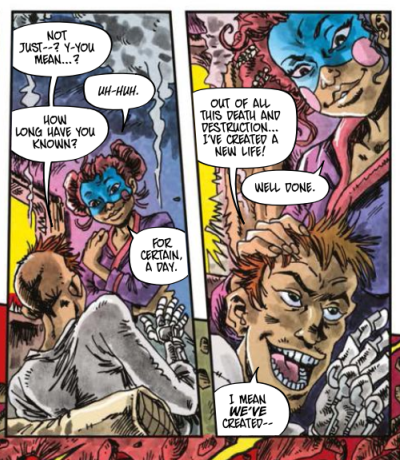
Now, before I start asking Rufus about the art – Peter, you’ve presumably seen what Rufus has produced for the Devil’s Railroad? What are your thoughts?
PM: Rufus’ wild art perfectly brings out both the alien-ness of our heroes and also what might be called their ‘humanity’. It seems to me that Rufus is a perfect 2000 AD artist, pulling off that difficult balancing act between dark drama, humour, and weirdness.
Rufus, when it comes to the visual side of things, how do you and Peter work?
RD: Peter is very trusting and really I just got on with drawing the series. One of the reasons I love 2000 AD is I have pretty much total freedom (working for US publishers the editorial teams often micro-manage your art and designs which, for me, really sucks the fun out of it). Matt Smith is very trusting and allows me to get on with making the series, I send it episode by episode and he approves it.
I am also in the lucky position of being the first reader of a new Peter Milligan series!! Haha! The 12-year-old me is doing a Snoopy happy dance.
Is it a case of working things through organically? Suggestions and visual ideas back and forth? Or is Peter the kind of writer content to describe and let you flesh out those visuals?
RD: Peter’s scripts are great as they are very barebones and basically descriptive of the action and location, which allows me to add and expand visually.
It’s up to me to make this grow into a visual world the reader will believe in. It’s the ideal set up. When writers give you hugely complicated scripts describing EVERYTHING, it’s very oppressive and often produces very poor results. Peter is a master of his craft, and trusts his co-creator to do their thing.
When I first saw that first episode, I was struck by a few things – firstly, most obviously, it has a very Rufus look. Of course it does, it would be wrong if it didn’t. But compared to the eye-popping exaggeration of Counterfeit Girl, or the insanity expressed in the art of Bad Company, it’s toned down a little here.
RD: Trust me…it will get a LOT more insane!! The first episode is to lull you into a false sense of security haha!
It will rollercoaster out from here once they get off planet! Our young couple face many, many challenges ahead, and will meet some incredibly unsavoury characters!!!
I needed the first part to be very clear, as it’s our introduction, so it’s more straight forward, but as the story progresses it really gets very complicated and more than a bit weird with a lot of extremely strange characters and places!
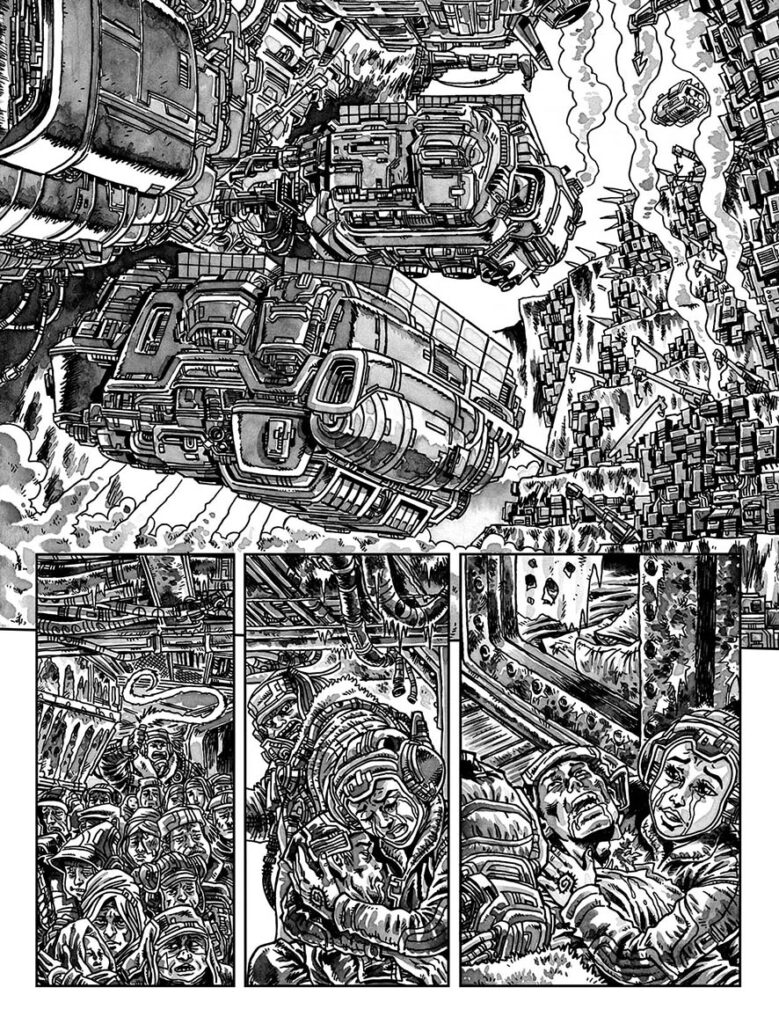
And just maybe some of those European stylings coming through in Rufus’ work?
Secondly, it struck me as recognisably European. Maybe it’s because I recently re-read a number of them, maybe it’s the space setting, but I’m seeing an awful lot of Jean-Claude Mézières and Valerian & Laureline in your art, something I’d never connected to it before.
In the past, I’ve talked with you about the influences of the likes of Brett Ewins and Brendan McCarthy on your artwork and the way it informed your upbringing in comics, what you described in the past as ‘cheeky, playful madness, a psychedelic edge to everything.’ But seeing Devil’s Railroad and making that connection with Euro comics, is it something that’s influenced you at all over the years?
RD: I will have to google those guys, as I don’t know their work. Brett and Brendan were definitely my starting points as a young scribbler… not least because Brett often mentored me… but until recently I had not seen many European comics. (I now live in France, so am starting to learn more about Bande Desinnée!!)
Rufus, you won’t be disappointed – Valerian & Laureline is just a superb series.
Will we be getting an explanation at some point for Constance’s blue and pink facial features? And Palamon’s metal right arm? What’s the story with that?
PM: All will be revealed. But if there’s a message it’s that these weird features are pretty surface and beneath them are emotions, dreams, and desires not so very different from our own.
RD: I gave Palomon a prosthetic arm as I wanted it to be a visual reminder of why they are leaving. It’s dangerous where they are. Everything is getting destroyed, and it’s only a matter of time before they are added to the body count. There is no story per se behind it (although I actually wrote notes of one for myself) It’s a visual metaphor.
I wanted Constance and other women from their planet to have very specific styles of dress and make up/tattooing that marks out their cultures, much like Berber/Amazigh culture in North Africa (My wife is part Algerian French, and we both love the tattoos and facial makeup of their culture, and it definitely influenced my thinking.) That’s why Palomon has a little space Fez too!
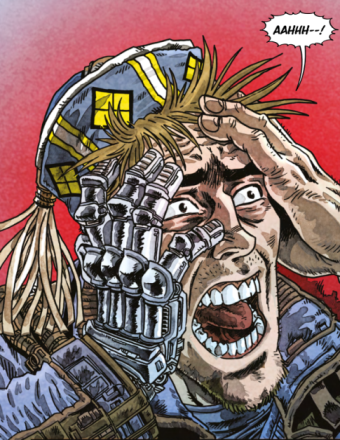
And of course, while we’re talking art, we should also be mentioning the colours here, provided by Jose Villarrubia. First of all, how did you get one of the premier US colourists involved?
RD: That was all thanks to Tharg! Peter and I have worked with Jose a few times at Vertigo on short stories! When Matt Smith told me that Jose was colouring it I freaked out! I am excited to see it myself, as I haven’t seen any of the coloured art yet! (I’ve just seen the first episode, and I love it!)
And second, what is it, do you think, that he brings to the strip?
RD: Well…he is brilliant!! I still can’t believe I am working with Peter, Jose and Jim… it’s a dream team (for me!!)
In previous strips, with Dom Regan on colours, you talked of the collaborative process between artist and colourist to get a finished page that all felt happy with. Was it the same with Jose?
RD: With Jose, I initially sent some colour notes, but I really haven’t communicated with him at all! I can’t wait to see what he has done.
With Dom, we are mates, so we would talk extensively, and collaborate. I love his crazy style. I hope we can work together again soon!
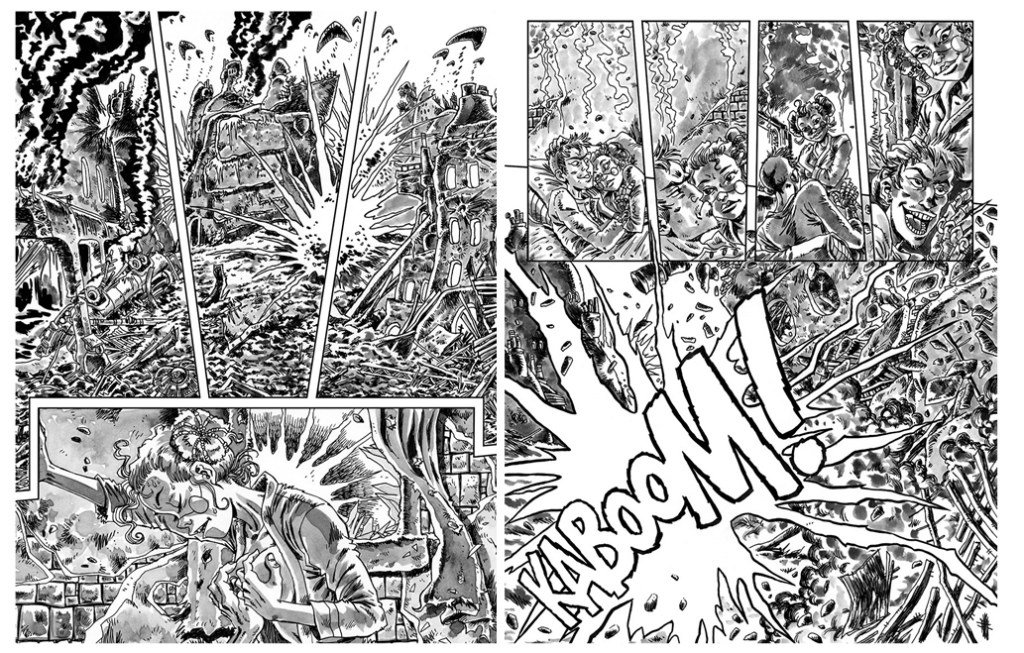
All that lovely painted acrylic ink tone!
Rufus, can you both take us through your processes in putting together the pages? Is it one very similar to your previous work?
RD: I thumbnail out the whole episode before starting any actual finished pages.
I then rough them out in pencil, ink, and then I painted tones on them with Acrylic ink! That’s always a bit nerve wracking, because if you bugger it up… you have to redraw the whole page! About halfway through the series I switched to digital paint for the tones… as I was having trouble with the paper bleeding the ink lines! It actually takes me longer digitally! So much for technology!!!
Now, as far as the future of The Devil’s Railroad, we’re seeing what is the first stage of Constance and Palamon’s trip to Earth begin here – it’s referred to as that when we join them on the mineral transporter.
So I assume you’ve written and drawn it with the intent and the hope that we’ll be seeing a second series (or more – hey, it’s always good to hope!)?
PM: To paraphrase Beckett (by way of Saint Augustine) Do not despair, one of the thieves was saved. Do not presume (or assume) one of the thieves was damned.
RD: Oh don’t you worry, they get to Earth!!! As I mentioned earlier, they are under the misconception they will be welcomed. Earth is just as problematic as the journey was for them!
This series has a proper beginning, middle, and end… but that’s not to say that everything gets wrapped up the way anyone wants things……
In fact, a story structured like this could really run as long as either you or Tharg want it to – each series bringing the pair that much closer as the next stage of their journey is undertaken.
RD: You’ve been watching too much Battlestar Galactica haha!
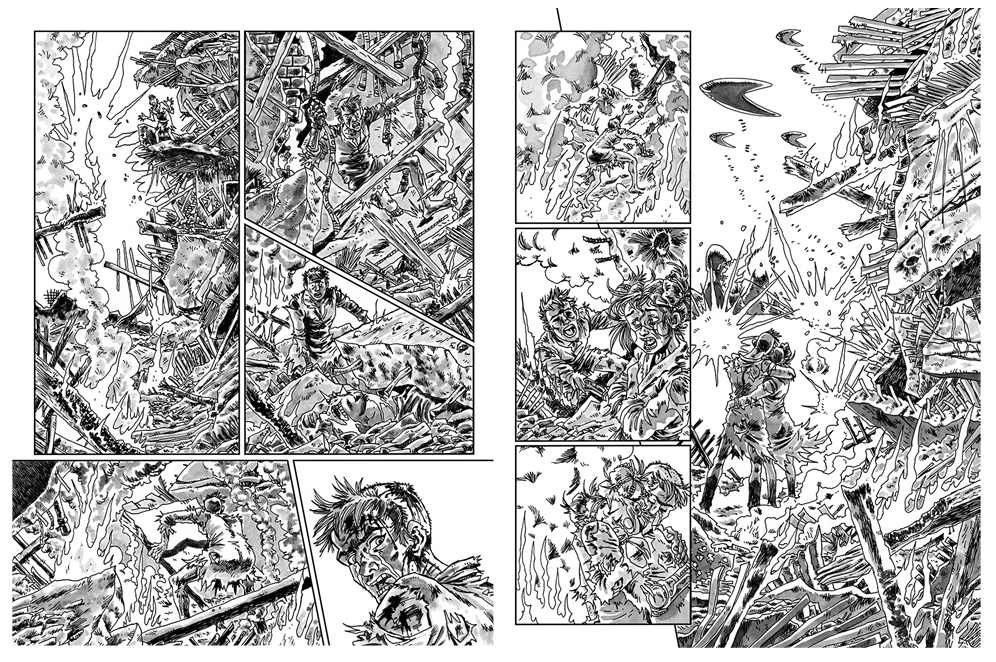
Episode 1 of The Devil’s Railroad – Prog 2352
Any word from Tharg yet on the possibilities of renewal for a second season?
PM: Let’s have the first season run first and see how everyone feels.
RD: Right now, I am just thankful to have finished this. When is started, I moved from the UK to France, got stuck in 3 huge lockdowns (they were very serious here, and I got stuck without all my stuff), then have been trying to renovate a derelict 200-year-old shop all by myself with my wife (with no plumbing or electricity) into a home while drawing a series.
To say Tharg has been patient would be an understatement. But I now have a home, my stuff, and even electricity!
And as for the future for both of you, what’s coming up from you next after Devil’s Railroad?
PM: I have a few projects at Vault, Mad Cave and Boom Studios. More information coming soon.
RD: A total oil rejuve for a very tired Art droid. Then new comics!!!
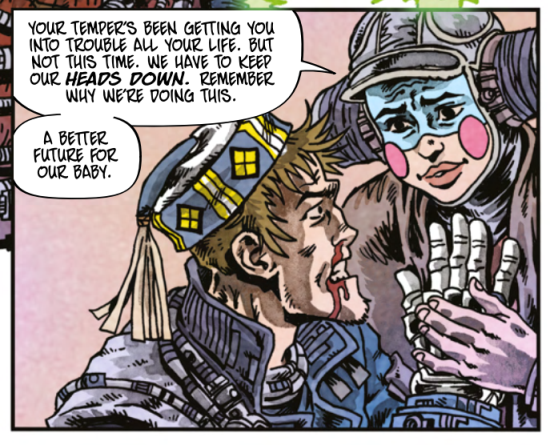
Thank you so much to both Peter and Rufus for taking the time – always much appreciated!
Their new series, The Devil’s Railroad, began in 2000 AD Prog 2352 and continues, right now, in the Prog – get it from anywhere the Galaxy’s Greatest is sold, including the 2000 AD web shop.
We’ve talked with Peter and Rufus a couple of times before this about their work together, catching up with them in 2017 for Bad Company: Terrorists here and for Counterfeit Girl in 2019 here.
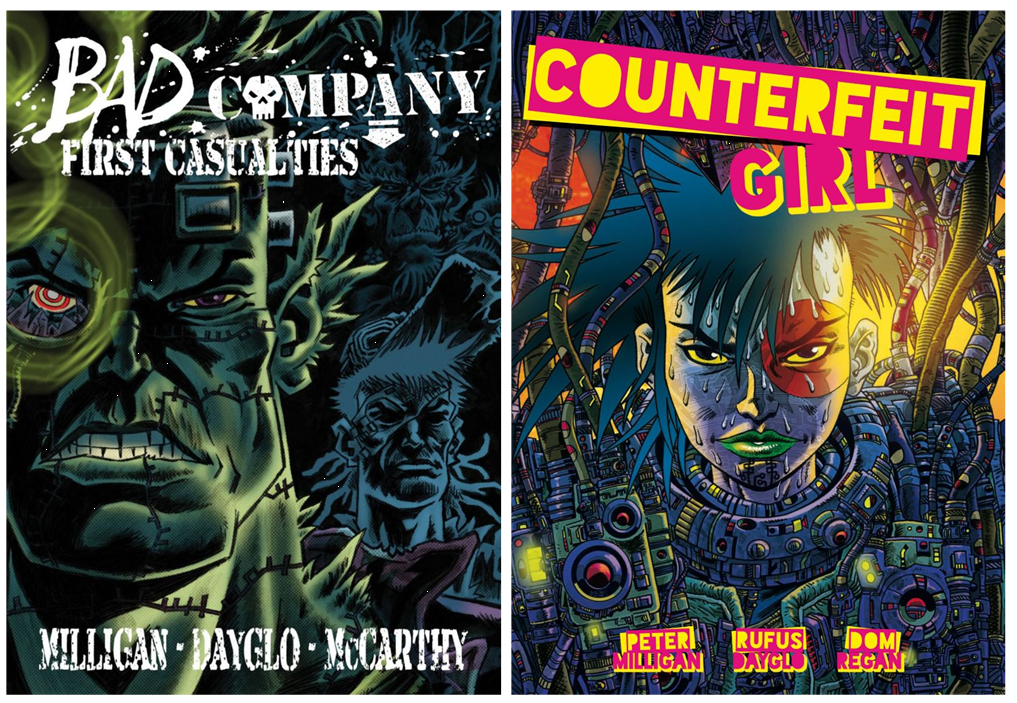
And their previous works together should be readily available – the dystopian cyberpunk of Counterfeit Girl, all identity theft, sentient diseases and fake news, is available in a collection. The two Bad Company series they’ve done together, First Casualties and Terrorists, can be found in Progs 1950-1961 and Progs 2061-2072. First Casualties is also available in a digital collection. And of course, you should all be picking up copies of The Complete Bad Company by Peter Milligan, Brett Ewins, Jim McCarthy, and Steve Dillon.
And now, before we go… the full size versions of those great Rufus designs and process pieces…
